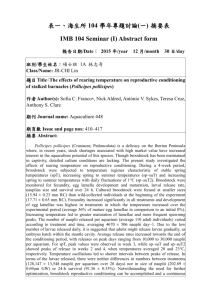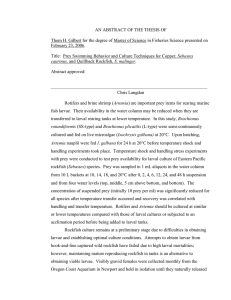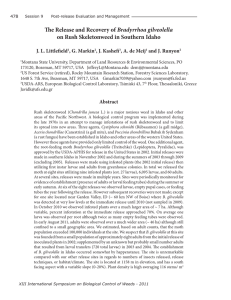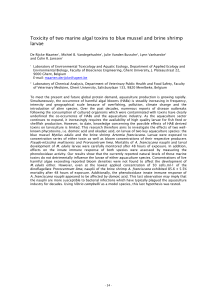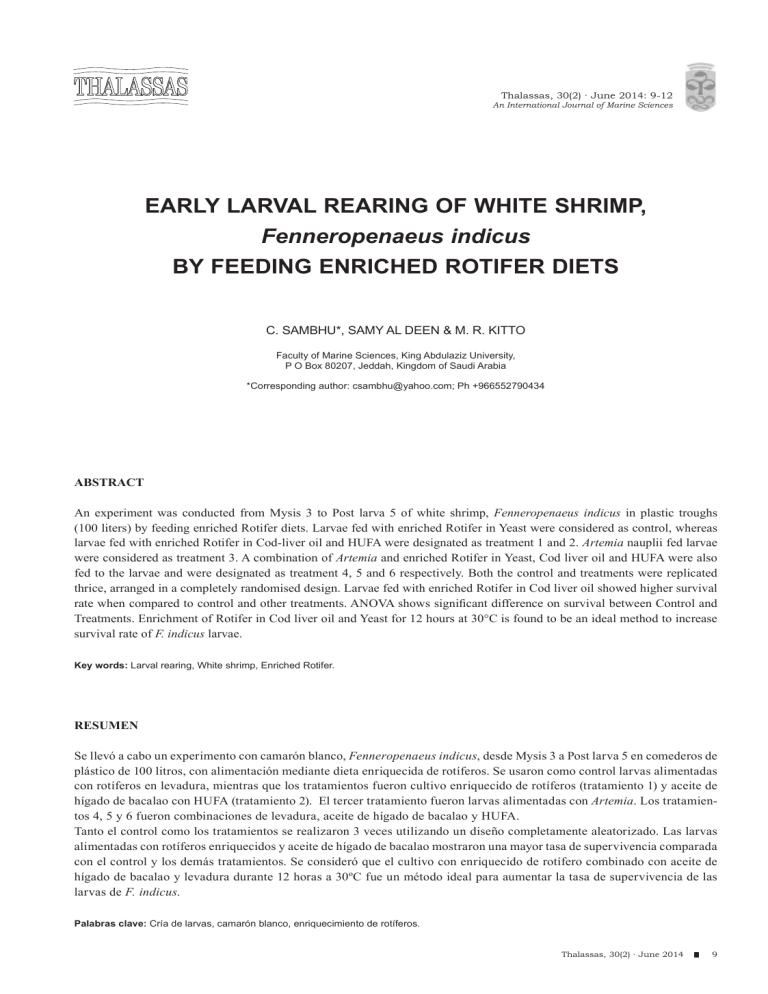
Thalassas, 30(2) · June 2014: 9-12
An International Journal of Marine Sciences
EARLY LARVAL REARINg oF WHITE SHRIMP,
Fenneropenaeus indicus
BY FEEDINg ENRICHED RoTIFER DIETS
c. sambhU*, samy al deen & m. r. kiTTo
Faculty of marine sciences, king abdulaziz University,
P o box 80207, Jeddah, kingdom of saudi arabia
*corresponding author: csambhu@yahoo.com; Ph +966552790434
ABSTRACT
An experiment was conducted from Mysis 3 to Post larva 5 of white shrimp, Fenneropenaeus indicus in plastic troughs
(100 liters) by feeding enriched Rotifer diets. Larvae fed with enriched Rotifer in Yeast were considered as control, whereas larvae fed with enriched Rotifer in Cod-liver oil and HUFA were designated as treatment 1 and 2. Artemia nauplii fed larvae were considered as treatment 3. A combination of Artemia and enriched Rotifer in Yeast, Cod liver oil and HUFA were also fed to the larvae and were designated as treatment 4, 5 and 6 respectively. Both the control and treatments were replicated thrice, arranged in a completely randomised design. Larvae fed with enriched Rotifer in Cod liver oil showed higher survival rate when compared to control and other treatments. ANOVA shows significant difference on survival between Control and
Treatments. Enrichment of Rotifer in Cod liver oil and Yeast for 12 hours at 30°C is found to be an ideal method to increase survival rate of F. indicus larvae.
Key words: larval rearing, white shrimp, enriched rotifer.
RESUMEN
Se llevó a cabo un experimento con camarón blanco, Fenneropenaeus indicus , desde Mysis 3 a Post larva 5 en comederos de plástico de 100 litros, con alimentación mediante dieta enriquecida de rotíferos. Se usaron como control larvas alimentadas con rotíferos en levadura, mientras que los tratamientos fueron cultivo enriquecido de rotíferos (tratamiento 1) y aceite de hígado de bacalao con HUFA (tratamiento 2). El tercer tratamiento fueron larvas alimentadas con Artemia . Los tratamientos 4, 5 y 6 fueron combinaciones de levadura, aceite de hígado de bacalao y HUFA.
Tanto el control como los tratamientos se realizaron 3 veces utilizando un diseño completamente aleatorizado. Las larvas alimentadas con rotíferos enriquecidos y aceite de hígado de bacalao mostraron una mayor tasa de supervivencia comparada con el control y los demás tratamientos. Se consideró que el cultivo con enriquecido de rotífero combinado con aceite de hígado de bacalao y levadura durante 12 horas a 30ºC fue un método ideal para aumentar la tasa de supervivencia de las larvas de F. indicus .
Palabras clave: cría de larvas, camarón blanco, enriquecimiento de rotíferos.
Thalassas, 30(2) · June 2014 9
C. SaMbhU, SaMy al DeeN & M. R. KITTo
Table 1: Feeding table for larval rearing.
Larvae
M3
PL1
PL2
PL3
Rotifer
10/ml
15/ml
20/ml
25/ml
Artemia
5/ml
5/ml
10/ml
10/ml
Rotifer+Artemia
5+3/ml
8+3ml
10+5/ml
12+5/ml
PL4
PL5
30/ml
50/ml
20/ml
20/ml
15+10/ml
25+10/ml
Feeding time and feeds
Stage 6 AM 10 AM 1 PM 3 PM 6 PM 9 PM 12 AM
Larvae RC
Live feed
RC-Royal Cavier (100µ)
RC
Live feed
RC
Live feed
RC
Rotifers are the most widely used live feed in intensive aquaculture (Srivastava et al ., 2011). Its body size makes this organism an appropriate prey at start feeding.
It also has high population growth rate at high densities and it feeds by filtrating particles in suspension which makes it easy to enrich with potentially lacking nutrients. Yet the widespread use of these food organisms, there is little information only on commercial usages of
HUFA-enriched Brachionus in Fenneropenaeus indicus early larviculture. Emmerson (1984) studied the predation and energetics of Penaeus indicus larvae feeding on Brachionus plicatilis and Artemia nauplii. Donald and Darryl (1988) evaluated the rotifer, Brachionus plicatilis as a substitute for Artemia in feeding larvae of Macrobrachium rosenbergii.
Samocha et al ., 1989 worked on the effect of feeding two prey organisms, nauplii of Artemia and rotifers, Brachionus plicatilis
(Muller), upon survival and growth of Penaeus semisulcatus (de Haan) larvae. Research studies also included enriched rotifers in larval feeding regime ( L. vannamei ) from Z2 to M3/PL1 at densities 20-40/ml/day (Naessens et al ., 1995; Wouters et al ., 1997). However, studies on larval rearing in white shrimp, F.indicus
are scanty.
Therefore a study was conducted to evaluate the efficiency of feeding enriched Rotifer, Brachionus plicatilis in various media on survival of early larvae of Indian white shrimp, Fenneropenaeus indicus an ideal candidate species for coastal aquaculture. nauplii fed larvae were considered as treatment 3. A combination of Artemia nauplii and enriched Rotifer in
Yeast, Cod liver oil and HUFA were also fed to the larvae and were considered as treatment 4, 5 and 6 respectively.
Both the control and treatments were replicated thrice and arranged in a completely randomised design. Uniform size Mysis 3 were produced in the Hatchery and stocked at the rate of 100/liter in each trough. Larvae were fed from
Mysis 3 stage to PL5 based on a feeding table designed for larval rearing in the Hatchery (Table 1).
RESULTS
MATERIALS AND METHODS
Micro encapsulated feed, Royal Cavier (100 µ) was fed to the larvae at 6:00 AM, 1:00 PM, 6:00PM and 12:00 PM and 50% water exchange was done at every day morning.
Required quantity of Rotifer was cultured in the Hatchery.
Stock of Rotifer was grown on standard diet (Baker’s yeast) as per the procedure recommended by Theilacker and
MacMaster (1971). Rotifer was enriched in Cod liver oil which was procured from Seven Seas, Taiwan and HUFA from Espresso, Taiwan. Enrichment was done for a period of 12 hours by keeping Rotifer in each medium at 30 o C.
After enrichment, Rotifer was harvested and cleaned with filtered seawater and fed to the larvae as per the feeding table. Upon harvest of post larvae, survival in control and treatment tanks was recorded and compared. One way analysis of variance (ANOVA) was employed to find out the statistical significance on deference in survival between control and treatment means. Duncan’s multiple range tests was done to compare the treatment means.
The experiment was conducted for a period of one week in plastic troughs (50 liters) in the larval rearing section of Fish Farm Hatchery, Faculty of Marine Science.
There was control and treatments for the study. Larvae fed with enriched Rotifer in Yeast was considered as control, whereas larvae fed with enriched Rotifer in Cod-liver oil and HUFA were designated as treatment 1 and 2. Artemia
Data on larval rearing of Mysis are shown in Table 2.
Larvae fed with enriched Rotifer in Cod liver oil showed higher survival when compared to control and treatments
(Fig.1). Lowest survival was observed in T6 which was fed by a combination of Artemia nauplii and enriched
Rotifer in HUFA. Larvae fed with Artemia nauplii alone were found to be healthy and the survival was as good as
Control. Combination of Artemia nauplii and enriched
10 Thalassas, 30(2) · June 2014
eaRly laRVal ReaRING oF WhITe ShRIMP, Fenneropenaeus indicus by FeeDING eNRICheD RoTIFeR DIeTS
Table 2: Survival of post larvae fed with enriched Rotifer diets.
Parameters
Initial number
Final number*
Survival(%)
Control T1 T2 T3 T4 T5 T6
M ±SD M ±SD M ±SD M ±SD M ±SD M ±SD M ±SD
5000±12 5000±12 5000±12 5000±12 5000±12 5000±12 5000±12
1908±74 b 2294±41 a
38±08 46±11
1106±59 c 1910±98 b 1307±73 c
22±09 38±05 26±09
1203±90 c 504±88 d
24±02 10±04
*P<0.05; a,b,c: Means with the same superscript do not differ from each other (Duncan’s test) rotifer did not show high survival rate when compared to
Control. ANOVA shows that there is significant difference
(p<0.05) in survival between control and treatments.
could capture Rotifer effortlessly than Artemia and thereby it could bring higher survival.
nauplii
DISCUSSION
The major bottleneck of shrimp larviculture is the rearing or early larval stages (Agh and Sorgeloos,
2005). Larval rearing of shrimp is dependent upon the availability of live food, which is expensive to obtain on a commercial scale. Several reasons can justify why live food is so essential for larval growth. In nature the larvae of shrimp feed on motile prey organisms and encounter problems in accepting inert diets in captivity (Kolkovski,
2001; Sargent et al ., 2002). Rotifers and Artemia are the two live feeds most commonly used in shrimp larval rearing. The nutritional effectiveness of a live feed is in the first place determined by its ingestibility and, as a consequence, by its size (Agh and Sorgeloos, 2005).
Prey size is particularly important for shrimp larvae that have very small feeding appendages. In these cases, larvae should be fed rotifers as first food because Artemia nauplii are too large. Shrimp larvae can capture with their feeding appendages and therefore prey size is important
(Faleiro and Narciso, 2009). In the present study, survival rate in the larvae fed with enriched rotifer in cod liver oil showed highest value when compared to the larvae fed with Artemia nauplii. This shows that shrimp larvae
Nutritional quality of prey is an important aspect to consider in shrimp larval rearing. Lipids represent the most important energy source during embryonic development and essential fatty acids, such as the highly unsaturated fatty acids (HUFA) EPA (20:5n-3, eicosapentaenoic acid) and DHA (22:6n-3, docosahexaenoic acid), are extremely important for larval development, especially in improving neural functions (Bell et al ., 1995; Sargent et al ., 2002).
Although nutritional deficiencies in prey quality can be overcome through enrichment with essential fatty acids, high HUFA levels are difficult to accumulate in
Artemia nauplii due to their inherent catabolism of DHA.
In contrast, rotifers are not selective for the uptake or catabolism of HUFA and high levels of DHA are easily incorporated in these organisms (Dhert et al ., 1993). The higher survival in larvae fed with Rotifer enriched with cod liver oil maybe due to the presence of fatty acids in cod liver oil (Faleiro and Narciso, 2009). Recently Yahyavi and
Takami, (2007) reported better survival with cod liver oil enriched rotifer than non-enriched Artemia. Regunathan
(2005) researched on differential rotifer enrichment diets for F. indicus larval rearing and concluded that protein selco enriched rotifer could replace non-enriched artemia from Zoea 2 to Mysis 2 stage with similar survival and till
Mysis 3 with non-significant survival compromise.
Figure 1: Survival (%) of post larvae fed different diets.
Thalassas, 30(2) · June 2014 11
C. SaMbhU, SaMy al DeeN & M. R. KITTo
Besides prey ingestibility, differences in Brachionus and Artemia nauplii digestibility and nutritional quality may also be important. Crustacean larvae have a poor digestive capacity, probably due to an insufficient enzymatic activity (Hammer et al ., 2000; Kolkovski,
2001), which can be improved by exogenous enzymes from preys (Kolkovski, 2001). In carnivorous larvae, prey digestibility is particularly important because they have a short gut retention time, particularly during the early larval stages, making the rapid digestion so critical
(D’Abramo, 2002). The digestive capacity of a species varies with the prey and is probably related with their natural diet. In the present study, Artemia nauplii fed larvae were found to be low survival compared to control and other treatments and this may be due to the meager digestibility of Artemia nauplii by post larvae.
This study demonstrated that rotifers are essential for larvae survival and for the development of early larval stages in white shrimp larviculture, but also that enriched rotifers can be successfully used for larval rearing of P. indicus .
ACKNOWLEDGEMENTS
We thank our Dean, Faculty of Marine Science, King
Abdulaziz University for providing the support to carry out the study. Our sincere thanks to National Prawn
Company, Al Lith, Jeddah for the facilities extended.
REFERENCE
Agh N, Sorgeloos P, (2005). Handbook of Protocols and
Guidelines for Culture and Enrichment of Live Food for
Use in Larviculture. Artemia & Aquatic Animals Research
Center, Urmia University, Urmia. 60 pp.
Bell MV, Batty R, Navarro JC, Sargent JR, Dick JR, (1995).
Dietary deficiency of docosahexaenoic acid impairs vision at low light intensities in juvenile herring ( Clupea harengus
L.), Lipids 30: 443-449.
D’Abramo LR, (2002). Challenges in developing successful formulated feed for culture of larval fish and crustaceans.
In: Cruz-Suárez, L.E., Ricque-Marie, D., Tapia-Salazar,
M., Gaxiola-Cortés, M.G., Simoes, N. (Eds.), Avances en Nutrición Acuícola VI. Memorias del VI Simposium
Internacional de Nutrición Acuícola, 3–6 September 2002,
Cancún, Quintana Roo, Mexico.
Dhert P, Sorgeloos P, Devresse B, (1993). Contributions towards a specific DHA enrichment in the live food Brachionus plicatilis and Artemia sp. In: Reinertsen, H., Dahle, L.A., Jorgensen, L.,
Tvinnereim, K. (Eds.), Fish Farming Technology. Balkema,
(Received: May, 13, 2013; Accepted: February, 14, 2014)
Rotterdam, Netherlands, pp. 1090-115.
Donald L, Darryl L, (1988). Evaluation of the rotifer Brachionus plicatilis as a substitute for Artemia in feeding larvae of
Macrobrachium rosenbergii , Aquaculture, 71 (4) : 331-338.
Emmerson WD, (1984). Predation and energetics of Penaeus indicus (Decapoda: Penaeidae) larvae feeding on Brachionus plicatilis and Artemia nauplii, Aquaculture, 38 (3): 201-209.
Faleiro F, Narciso L, (2009). Brachionus vs Artemia duel:
Optimizing first feeding of Upogebia pusilla
(Decapoda:Thalassinidea) larvae, Aquaculture, 295: 205-208.
Hammer HS, Bishop CD, Watts SA, (2000). Activities of three digestive enzymes during development in the crayfish
Procambarus clarkii (Decapoda). Journal of Crustacean
Biolology, 20 (4): 614-620.
Kolkovski S, (2001). Digestive enzymes in fish larvae and juveniles - implications and applications to formulated diets.
Aquaculture, 200: 181-200.
Naessens E, Wouters R, Cobo ML, Vargas V, Pedrazzoli A, Van
Hauwaert A, Lavens P, (1995). Effect of n-3 HUFA and DHA
/ EPA ratio in enriched live feed on fatty acid composition and culture performance of Penaeus vannamei larvae,
Special Publication of European Aquaculture Society, 24:
213-216.
Regunathan C, (2005). Regulation of critical control points using advanced biotools for the improved larviculture performance of Fenneropenaeus indicus , Ph.D. thesis,
M.S.University, Tamilnadu, India, 230pp.
Samocha TM, Uziel N, Browdy CL, (1989). The effect of feeding two prey organisms, nauplii of Artemia and rotifers,
Brachionus plicatilis (Muller), upon survival and growth of larval marine shrimp, Penaeus semisulcatus (de Haan),
Aquaculture, 77(1): 11-19.
Sargent JR, Tocher DR, Bell, JG, (2002). The lipids. In: Halver,
J.E., Hardy, D.M. (Eds.), Fish Nutrition. Elsevier Science,
USA, pp. 181-257.
Srivastava A, Stoss J, Hamre K, (2011). A study on enrichment of the rotifer Brachionus “Cayman” with iodine and selected vitamins, Aquaculture, 319:430-438.
Theilacker, GH, MacMaster MF, (1971). Mass culture of the rotifer, Brachionus plicatilis and its evaluation as a food for larval anchovies. Marine Biology, 10: 183-188.
Wouters R, Hauwaert AV, Naessens E, Ramos X, Pedrazzoli A,
Lavens P, (1997). The effect of dietary n-3 HUFA and 22:6 n-s / 20:5 n-3 ratio on white shrimp larvae and postlarvae,
Aquaculture International, 5 : 113-126.
Yahyavi M, Takami A, (2007). The study of Indian white shrimp larvae feeding ( Fennerpenaeus indicus ) by enriched rotifer with Unsaturated Fatty acids (DHA, EPA) and Vitamin C,
Pajouhesh-va-Sazandegi, 74: 140-149.
12 Thalassas, 30(2) · June 2014
